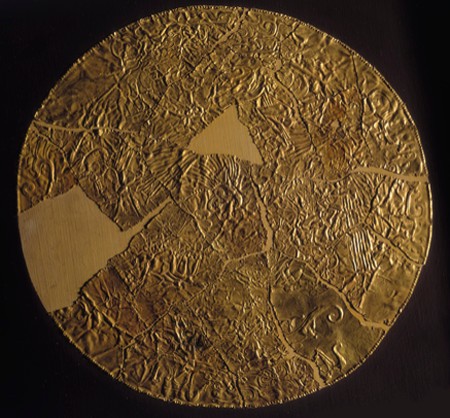In the first decade of the twentieth century, one whole and seventeen fragmentary gold foil disks with repoussé imagery were found sixty-five feet below the water’s surface in the Sacred Cenote of Chichen Itza, Yucatan, Mexico, as part of a dredging and diving effort sponsored by Harvard University’s Peabody Museum that yielded thousands of artifacts from this natural sinkhole. Each gold disk had been burned, leaving carbonaceous, sooty smudges; after burning, most disks were ripped into small pieces. These pieces, along with the whole disk, were then crumpled and crushed before being hurled into the water. Today these disks and other gold offerings constitute nearly all the known gold from the Maya world and about half the known pre-Hispanic gold of Mexico, among the few works to survive Spanish sacking of the country. When the Maya first encountered gold in the ninth century, they saw the power of the sun in its material. They, like the later Aztec culture, understood it to be solar excrement, buried in the earth to be rediscovered as nodules that would wash out of stream beds, to be reconstituted in forms that would engage the sun.
Maya artists learned to work gold from lower Central American masters, who brought plain disks to Chichen Itza in the later ninth century, probably during the reign of K’ak’upacal, a king who presided over the introduction of new art forms and new religious forms and practice. The imagery of the disks suggests unsettled times, even for artists, who juxtaposed subtle renderings of the human form, old-fashioned by this date, with new sky deities.
Usually considered in isolation because of their material and the seeming novelty of their imagery, the gold disks have a provenience within the vast stew of the Sacred Cenote, among the detritus of a multicentury sacrificial practice that included, in addition to the disks, at least three tons of blue pigment; hundreds of kilograms of copal and rubber incense; the bones of approximately two hundred fifty humans; thousands of pots, mostly in sherds; thousands of jades; hundreds of wooden objects; dozens of textiles; and worked gold objects—many of them tiny cast frogs—from Panama. A few chips of turquoise can be sourced to the Los Cerrillos mines of New Mexico, and thousands of copper bells came from north of Acapulco, making this vast sinkhole one of the great nodes of ancient Mesoamerica circa 1000. The blue pigment was produced through heating a gray clay with a tiny amount of indigo; the incense was burned at the sinkhole’s edge, yielding clouds of strong-smelling smoke. Both processes may have been magical ones, in which one material became another, transformed by fire. What was the moment when a leader of a ritual may have burned the gold disks, ripped them apart, apportioned pieces, as in the sacrifice of an animal or of a human, and then invoked their total destruction? We cannot know. Perhaps even more valuable than gold, burning jades shattered when they hit the water, invoking for a modern reader the words of a later Aztec poet, who pondered the ephemerality of life: “Even jade is shattered, even gold is crushed,” a veritable description of practice at the Cenote’s edge.
Many rituals would have been performed there, invocations to rain
and maize deities among the most common; hundreds of dancing, chanting, and singing observants would have rimmed the great orifice on many such occasions. But the greatest ritual of ancient Mesoamerica was the celebration of New Fire, a calendrical observance held every fifty-two years, at the intersection of the 260-day and 365-day calendars. Recorded in some detail at the time of the Spanish invasion, New Fire was last celebrated in 1507, when Aztec writers recalled five days of purging and destruction of objects, burning, termination of all fires, darkness, and renewal, ultimately made manifest by the kindling of fire in the open chest cavity of a sacrificial victim whose heart had been offered to the sun. Celebrated at Teotihuacan for much of the first millennium CE, New Fire may have become the major celebration at Chichen Itza, perhaps starting in 830, a few months after the Maya would have celebrated the completion of the tenth baktun 10.0.0.0.0 (March 13, 830), and with a locus at the Cenote. The disks may then have survived for only one or two cycles of the calendar, perhaps meeting their end in 934 or 986.
